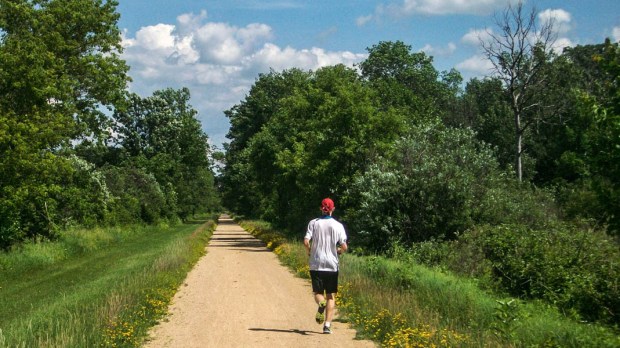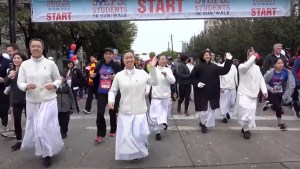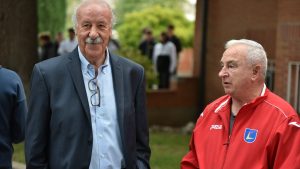Kyle Lang and his friends looked not too different from any other 20-somethings on the beach at New York’s Coney Island last summer. It was a Saturday near noon in the middle of August, with a high of 86, so it wasn’t surprising that they would take off their shirts, kick off their shoes and jump in the water.
But Lang had come a lot farther than most of the folks who were enjoying the beach, the boardwalk, the Nathan’s hot dogs and amusement park rides that day.
He had come from Washington state—on foot. Running.
Lang, 20, who was joined on the last day of a 76-day trek by a few friends from school, had completed a 3,016-mile run. Each day, with one or two exceptions, he ran about 40 miles—in essence, a daily marathon and a half.
Leaving North Cove, Washington, on June 5, Lang took a northerly route that brought him from the heights of the Rockies to the plains of the Midwest, skirting Chicago, and passing through his hometown of West Salem, Wisconsin, and his adopted state of New Jersey, where he is a junior at Princeton.
He wore out nine pairs of running shoes.
In an interview, he traced the origin of the cross-country adventure back to his grandfather, who gave him Christopher McDougall’s book Born to Run. The book “inspired me to run my first marathon, when I was 16,” Lang said. After that, he decided to run the length of a local bike trail, which is 101 miles, as part of a high school exit project. “I did it in two days to raise money for a couple of organizations.” Finding himself capable of running 40-50 miles a day, he was then inspired to take on the coast-to-coast challenge.
Encouragement
The ultramarathoner Marshall Ulrich spoke at Princeton, and his talk only added to Lang’s desire and confidence. Ulrich wrote about his run from California to New York at age 57, averaging 60 miles a day, in Running on Empty.
Lang began lining up corporate partners and sponsors and planning a route. During spring semester last year, he began training in earnest, doing 30- or 40-mile runs on weekends and 10- to 25-mile runs during the week, “to try to make sure I was capable of sustaining high mileage.” He would do 35 miles around a track, “just to get used to the mind-numbing boringness of what the summer might be.”
“My biggest thing was just going out and tackling the miles, making sure that a single 40-mile run ended up becoming no big deal, that it ended up being just another run,” he explained. “And the other big thing for me was relying on other people—relying on their prayers, relying on their support, relying on their encouragement.”
“The week before I started the run, my parents and I had a very serious conversation about what I would push myself to do and what signs we would have to look out for that might make us decide to take a day or or cut back miles or end the run completely,” he said. “I didn’t want to do any lasting damage to my body.”
Friends helped him set up a website for the run, which he dubbed Running United 2017. The site allowed followers to see exactly where he was on a map at any given moment.
Aside from running, Lang wanted to give back to nonprofits in three communities that have had a major impact on his life: Great Rivers United Way, which serves four counties in Wisconsin and Minnesota; Every Hand Joined, a cradle-to-career initiative serving the community of Red Wing, Minnesota, where he interned the previous summer, and Special Olympics New Jersey, which provides year-round sports training and athletic competition in a variety of Olympic-type sports for children and adults with intellectual disabilities.
He ended up raising about $23,000.
Lang’s parents—Mike and Cheryl—agreed to accompany him. They kicked off on June 5 and completed the journey August 19. His parents would drive a few miles ahead and wait for him to catch up, being ready to supply him with food and water, and, at the end of the day, finding a place to stay overnight, often a church or someone’s home.
“One of the cool things was seeing how the terrain changed across America: from the Rockies, to the flat, barren nothingness of Montana and Dakota, to the flat cornfields of Indiana and Ohio, and the rolling hills of Pennsylvania,” he said.
“Probably the most impactful experience was meeting a lot of people from different walks of life,” he said. “I was running through the middle of nowhere in Montana, for example, and a biker rolls up from behind, just randomly, and he’s like, ‘What on earth are you doing out here?’ How do I answer that. The first thing that came to mind was ‘I’m just headed to New York,’ and he said ‘Oh that’s cool,’ and he peddled alongside me for a couple of miles. It turned out that he was biking from Portland, Oregon, to Minneapolis, averaging about 120 miles a day, and this was like the 13th time he made that trip.”
Throughout the journey, he said, “thousands of people were, in a way, united in pursuit of the same goals: praying, giving back, and encouraging me to make it to the Atlantic Ocean. My family and I relied on the generosity of others (often strangers) all throughout the summer, from doing a load of laundry for us, to buying groceries, to checking on us parked on the side of the road to make sure we were okay. It was humbling that so many people went out of their way to help us complete the journey.”
Offering it up
It wasn’t always easygoing, of course. There were days when the temperature reached 105, and five or six days of running in heavy rain.
“I think the first two weeks, my body was just getting used to being on my feet 12 hours a day, saying ‘What are you doing? Why are you doing this? You shouldn’t be doing this.’ And my body tried to get me to stop. Around day 5 I developed shin splints in my right leg, and that forced me to take a full day off.”
There was mental exhaustion as well. “Once in Wisconsin, and after I ran through my home town, I just got so mentally exhausted that I almost felt like I had lost the ability to complete the journey,” he admitted. “I knew I was capable of waking up the next day and covering 40 miles. To me that didn’t feel like that big of a deal. My body had become so accustomed to what I had been doing for the last 50 days. But mentally I was just ready for it to be done.”
On his blog, Lang described some of what would go through his mind at times, particularly when the going got tough:
You don’t have to make it 40 miles. You just have to make it one mile. If you can’t make it one mile, just make it ten more steps. Then those ten steps will turn into ten more, and then you’ll have gone a mile, and then another mile, and then 40 miles.
Lang already had a way to direct his physical and mental challenges. At Princeton, where he is studying psychology, he got involved in Catholic campus ministry through the Aquinas Institute. He also got to know Opus Dei, the personal prelature founded by St. Josemaria Escriva and which emphasizes growing in holiness through one’s ordinary activities in everyday life. A member of Opus Dei he got to know at Princeton is also a runner and encouraged Lang to incorporate his faith into his sport.
“St. Josemaria’s writings on the ordinary life really spoke to me,” Lang explained. “The mundane tasks. Running can be compared to a mundane task—something that’s just repetitive. Being able to find meaning beyond the task itself is something I wanted to grasp and take hold of.”
His friend introduced him to the concept of “mile intentions,” offering up a length of a run to God as a sacrifice for a particular prayer intention.
“Generally, miles 12-16 in the morning were more difficult. And in the afternoon, the 7th to 10th mile were difficult,” he recalled. “I tried to plan for when I was at a mentally taxing point I would have a specific mile intention, so I could be thinking of that while I was going through a difficult stretch of the day.”
Thinking about them would help him carry on.
“Ultimately it was trying to align my suffering with the suffering of the person I was praying for, especially if I was praying for a loved one who was dealing with cancer or someone who’s dealing with loneliness,” he explained. “And also aligning it with Christ’s Passion. I would pray that the Lord would use my suffering to alleviate the suffering of others and what they were going through, whether that was peace in the Middle East or someone dealing with loneliness or the death of a friend’s parent.”
Ocean to ocean
On the last day, Lang started his run on the New Jersey side of the Hudson River, near the George Washington Bridge. His mother, who is also a runner, ran the whole 24 miles with him to Coney Island in Brooklyn. A couple of friends joined in at various points. Lang ran right through the campus of Ivy League rival Columbia University, down Broadway, through Times Square and Chinatown and across the Manhattan Bridge into Brooklyn. Seventy-six days after a pre-run dip in the Pacific Ocean, he was about to dive into the Atlantic.
“Coming down Ocean Parkway, you could feel the ocean breeze, and it just got quiet,” he recalled. “With about four miles to go, we started praying the Rosary, and there was silence for the last mile.”
According to Lang, about 500 people have gone coast to coast on foot. “Most probably walk it,” he said. “Probably between 12-20 have run it.”
He said that he hopes one day to run the perimeter of the United States: down the west coast, along the southern border, up the east coast and back along the northern border.
And, he added, “If I got the opportunity, I’d love to run the length of America from north to south, which is something like 28,000 miles. No one’s done that.”
This article was originally published on December 27, 2017.



